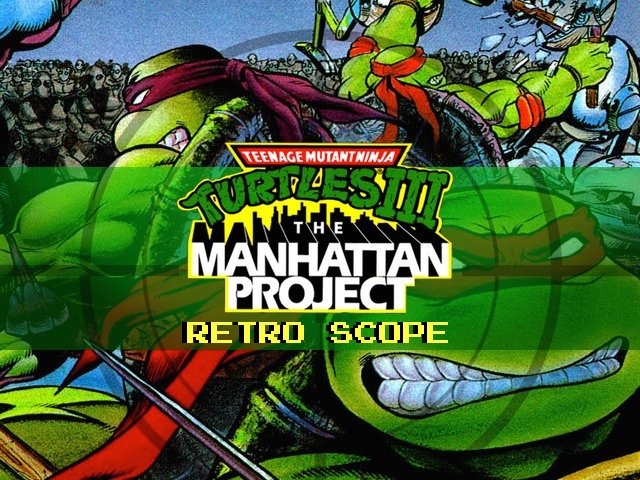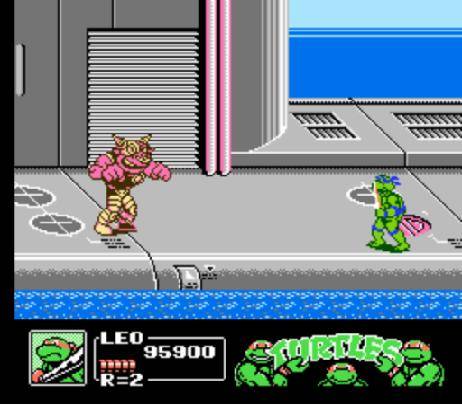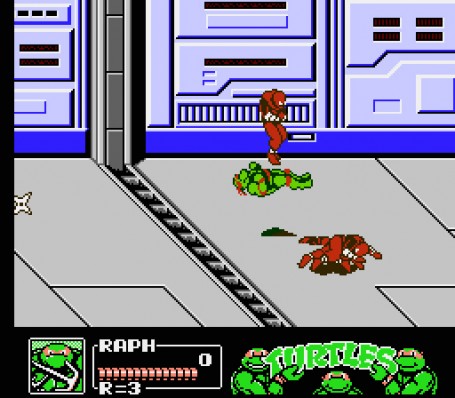
It’s hard to summarize what exactly made Konami’s Teenage Mutant Ninja Turtles games so good. Whether it’s the music, the excellent graphics, or the spot-on play control for each of the four brothers, Konami just seemed to understand the Ninja Turtles in a way that today’s developers haven’t been able to come close to. One game of the many that the company produced over the years that never gets much attention is this overlooked gem, Teenage Mutant Ninja Turtles III: The Manhattan Project. Unlike Teenage Mutant Ninja Turtles II: The Arcade Game, TMNT III is not a port, but its own original title that took the gameplay of its predecessor and expanded upon it. Boasting improved controls and graphics, this is a Ninja Turtles game that pushed NES to its limits and laughed in the face of the old axiom that licensed games are always terrible.
The game opened with the four brothers vacationing in Key West, Florida, and soaking up the sun on the beach. Their buddy, reporter April O’Neil, appeared on a conveniently-placed television set (seriously, where are they getting power from?!) doing a broadcast when suddenly their arch-nemesis Shredder snatched her away. Shredder went on to taunt the Ninja Turtles, lifting the island of Manhattan into the sky and declaring that if they want her and the city back, they’ll have to come and get them. As far as openings go, it was pretty epic. Konami really pushed NES further than most with TMNT III, as this opening cinematic demonstrates; the animation was minimal, but effective, and the imagery itself was incredibly detailed. Including the small cinema that played before the title screen, it’s clear that Konami went to great lengths to recreate the atmosphere of the Ninja Turtles cartoon.

TMNT III could be played two ways: single-player or two-player. The adventure unfolded the same way no matter how many players were plugged in, but in an interesting twist, there were two modes to choose from when playing with someone else. In A Mode, players occupied the screen together and fought the hordes of the Foot Clan, but never directly impacted one another. In B Mode, the setup was the same, except it was possible for players to hurt each other during the course of the game. It was a fun twist that added additional challenge for those who wanted it, requiring more careful, coordinated fights as opposed to mindlessly traversing the screen and mashing the attack button.
By 1992, SNES had already been released, making TMNT III one of the twilight releases of NES (the system actually saw games come out for it all the way until Wario’s Woods in 1994). Despite this, Konami didn’t skimp in the graphics department for the title. While TMNT II struggled with paring down the superior visuals of the arcade version of the game, TMNT III was built from the ground up to be on NES. The sprites for the Ninja Turtles and all of the enemies were considerably larger than the previous game’s, and very smoothly animated. There was also a great variety of TMNT baddies to soak in– Beebop, Rocksteady, Krang, Tokka, Rahzar, Super Shredder, Slash, and more all came into contact with the brothers over the course of their quest. Their attack patterns were all unique, and visually it’s astounding how distinct Konami was able to make each of the boss encounters.

Beyond the eye candy, TMNT III also offered better controls than TMNT II, as well. While still limited to NES’s two primary face buttons of A and B, the brothers were capable of a standard jump and attack, but also a powerful toss move that could be initiated by pressing down and then the attack button, or a devastating melee move by pressing attack and jump at the same time (at the expense of health). The majority of foes were Foot Soldiers, but they came in a fairly robust variety of colors and attack types, making it necessary to strategically flow between them all and avoid taking damage from their myriad attack patterns. It wasn’t as simple as just whaling on the attack button and hoping for the best, which is a hallmark of terrible brawling games. Throw in a killer soundtrack, and this was some mighty impressive Ninja Turtles fan service.
Sadly, with licensed games comes nauseatingly complicated legal rights, meaning that this particular Ninja Turtles title will likely never see the light of day again. Anyone capable of tracking down a copy and playing it is highly encouraged to do so. Games based on popular characters tend to be hit or miss in terms of quality, but Konami treated the Ninja Turtles like one of its own properties back in the day, cutting no corners to deliver a premier experience. It falls short of the bar eventually set by Teenage Mutant Ninja Turtles IV: Turtles in Time on SNES, but TMNT III is a wonderful game that retro enthusiasts and Ninja Turtle fans owe it to themselves to play. It does suffer from a somewhat tenacious difficulty level (I don’t know how past-Robert was able to blow through the enemies in this one so easily!), but it’s a small complaint that some practice will easily overcome. TMNT III is a solid NES release that helped demonstrate how much life the old system still had.




 ShareThis
ShareThis






This is a great game. Many memories of the first three games on NES, especially the first one though. That game was a bit…difficult. Those underwater sections…